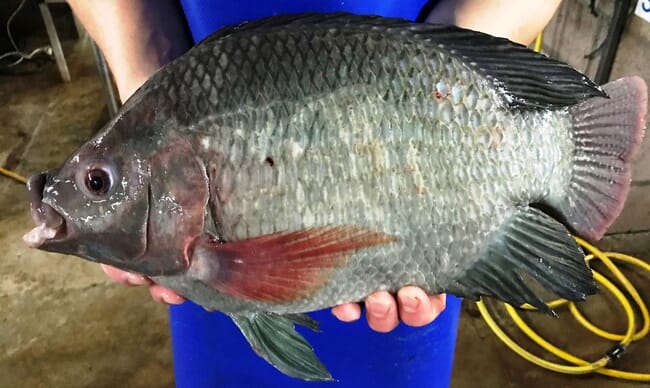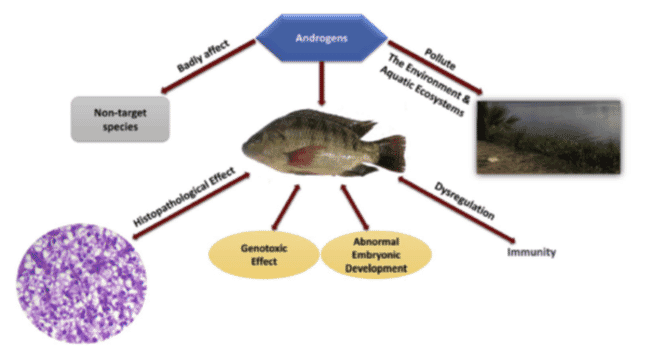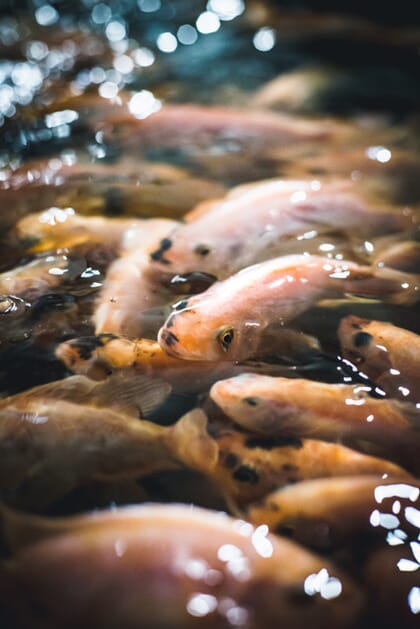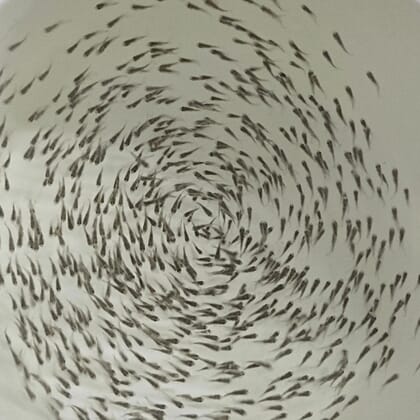Tilapia are among the world’s most farmed finfish – with 6.3 million tonnes (worth an estimated US $9 billion) – produced in 2018. From 2010 to 2016 production volumes leapt by an impressive 68 percent – an expansion that has brought numerous opportunities but also some serious challenges. Over the past five years, a number of viruses and other pathogens have been wreaking havoc on the tilapia sector, as recently reported on The Fish Site.

© Til Aqua
One of the main culprits is tilapia lake virus (TiLV), which was discovered in 2014 and causes up to 90 per cent mortalities. Until earlier this year it was thought that the virus only spreads between fish cultured in the same ponds via direct horizontal transmission, but new evidence suggests that it may also be transmitted vertically from broodstock to their eggs, fry and fingerlings, making the situation even more dire. Experts have warned that a social and economic catastrophe might transpire if the virus continues to wipe out tilapia stocks.
WorldFish, one of the main promotors of tilapia farming, is prioritising research to determine causes. So far it has concluded that, in the case of Egypt – where around 35 percent of farms have been suffering high mortality rates due to continued disease outbreaks – the deaths can be attributed to a variety of reasons, including water quality, temperature, density at harvest, lack of biosecurity and poor management practices. WorldFish admits that there is a pressing need to better understand the interactions between pathogens and components.
At the moment farmers are advised to combat TiLV and other disease outbreaks by increasing biosecurity, by more stringently screening newly acquired broodstock and fingerlings, and by decreasing potentially stress-inducing situations on their farms. However, scant attention has been given to determine and resolve the root causes of the increased occurrence of these disease outbreaks.
One of the main risk factors for TiLV, as suspected by the World Organisation for Animal Health (OIE), is stress. However, they also point out that some natural all-male strains of tilapia seem to be mostly unaffected by the virus. Why might this be the case?
Root causes
Increasing numbers of scientists believe that using testosterone or other hormonal products to stimulate sex-reversal and create all-male fry, the side effects of using large amounts of chemicals and veterinary drugs, and inbreeding, are three of the main root causes of TiLV that must be addressed.

© Abo-Al-Ela, 2018
Single sex populations, preferably all-male populations, have long been known to be favourable for tilapia producers, as their culture results in higher and more uniform growth rates. Unlike mammals, many fish have the possibility to change their sex. With tilapia, the easiest way of achieving this is through the use of hormones at the juvenile stage. By feeding the fry with certain steroids or by dipping them in water doused with steroids, sex change can be rapidly achieved. Although an assortment of steroids are used, the most common one is methyl testosterone.
Abo-Al-Ela (2018) recently provided a thorough overview of the many concerns associated with the use of steroids in aquaculture, including their effects on exposed farm staff, contamination of public waterways with residues, genotoxic effects and on supressing the immune systems of treated fish.
As Abo-Al-Ela explains, methyl testosterone is a severe endocrine disrupter and is known to induce genotoxic effects on human lymphocytes, which help regulate our immune systems. In Egypt, researchers have recently shown that tilapia treated with hormones have low levels lymphocytes plus white blood cells, which again play an important role in suppressing and combatting disease.
Similar research on Chinook salmon showed that fish treated with testosterone showed a significant decrease in antibody-producing cells. The magnitude of the steroid-induced immunosuppression was reduced in winter and increased again in spring, which might explain the comparable seasonality in disease outbreaks for tilapia as well.
An even less-investigated topic is the genotoxicity of these hormones and other chemicals, including antibiotics, used in aquaculture. Genotoxicity is described as the property of chemical agents which damages the genetic information of a cell, causing mutations which may lead to cancer. These permanent changes can be passed on to future generations of fish.
A recent study on the exposure of fish to antibiotics (including short-term exposure to low environmental concentrations often present in farming environments), revealed significant damage to the DNA of the fish as per Botelho et al. (2015). Although organisms can generally repair damaged DNA, some of the damage is most likely permanent and, worryingly, this damaged DNA can be passed on to future generations of tilapia.
Another understudied issue is the lack of genetic diversity in captive tilapia strains plus the loss of genetic diversity in aquaculture and wild fish stocks in general, as discussed in our recent article on invasive and non-native species. By using the same breeding stock for generation after generation without following sophisticated breeding programmes, which happens often in tilapia culture, inbreeding occurs and the number of alleles (gene variations) present in the fish is reduced. Some of these alleles might have bolstered disease resistance and pathogen defence, while others might have made the fish more adaptable to climate change or other situations.
Maintaining genetic diversity is key. A study characterising the genetic structure of introduced Nile tilapia strains in Tanzania showed a serious decline in genetic diversity for most of the locally-cultured tilapia strains. An important conclusion is that the effects of inbreeding and the consequent decline in genetic diversity are mostly affecting small-scale producers, who tend to have less knowledge of breeding programmes and less access to new breeding material.
If there is a link between the reduction of genetic diversity and reduced effectiveness of the immune systems of tilapia, then developing countries and small-scale farmers will most likely be hit the hardest, validating current reports from the field.
Solutions
Eric Bink is a Dutch fish farmer who is a strong believer in alternative and truly sustainable paths for the tilapia sector. Studying aquatic ecology, he early on developed an interest in food fish production. “I was primarily interested in fish production without artificial intervention, using natural spawning cycles and carefully manipulating light and temperature. I wanted to develop a fish farming system in a wholly different direction, away from (at the time) salmon (hormone injection), catfish (hormones and taking out parts of the testes) and shrimp (eye-stalk ablation).”
During a visit to Mombasa where his wife was finishing a veterinary degree, he visited a tilapia hatchery and saw an opportunity to start his own hatchery in the Netherlands. “Our operations don’t use hormones for sex-reversal. Instead we apply insights in fish genetics in combination with genetic selection, also known as YY-technology.”
Over 20 years have passed and Til-Aqua has become a leading player in the hatchery production of YY males, and natural male tilapia (XY males, the offspring of the YY males), the trademarked term used by the company.
In brief, YY technology uses genetic selection to produce all-male juveniles without the use of hormones, or other chemicals, as thoroughly explained in our article on monosex selection in Macrobrachium.
The company only uses genetic selection and careful temperature changes in the first days after hatching to change fish sex from male to female. The end product is a completely normal male with normal XY-chromosomes. This is in contrast with hormone sex-reversed tilapia, in which 50 percent of the phenotypical males are still genetically female and have XX chromosomes.

© Til-Aqua
Bink and his team have been perfecting this technology for the past 20 years and have developed two strong lines which they sell both as fingerlings (natural male tilapia) and broodstock (YY males). Their silver or wild type natural male tilapia reaches over 800 grams, making it ideal for either fillets or whole fish, while their red natural male tilapia is sold whole and performs very well in brackish and full-strength seawater systems.

© Gardsfisk
The company also provides tailor-made training programmes, successfully assisting companies across the globe, specifically in Africa and South America.
Bink explains that they have worked hard to maintain the genetic diversity of their strains by avoiding inbreeding. “Our way of breeding with two distinct O. niloticus lines (YY line and female line) shows a heterosis effect,” he explains.
Also known as hybrid vigour, this means when two breeding lines are crossed together, the resulting hybrids are often more robust, vigorous and productive than their original parents.
Unsurprisingly, the aforementioned study, which determined genetic diversity in selected tilapia strains, scored Til-Aqua’s silver strain as the most genetically diverse.
Several researchers have also used their breeding lines for experiments with the TiLV virus and other diseases, with the results being very optimistic. Though not all results are conclusive, even OIE notes on the TiLV disease card for tilapia that: “There is evidence that certain genetic strains of tilapia are resistant. Ferguson et al. (2014) noted that one strain of tilapia (genetically male tilapia) incurred a significantly lower level of mortality (10 – 20 percent) compared with other strains.”
The paper mentioned by OIE argues that the most likely cause for this would be the genetic make-up of the fish or the fact that they have not been subjected to feeding with methyl testosterone early in life. Either way, it shows there is a solution for farmers. In line with these findings, Bink and his team hope to develop a TiLV-resistant YY-line in the future.
“Unfortunately our company cannot afford such a long and expensive project at the moment. But we are definitely open to collaboration,” he explains.

© Til-Aqua
Future developments
To bring the tilapia sector back on track, the unique resistance of Til-Aqua’s tilapia against TiLV should be better understood. For this purpose more research must be conducted to ascertain the relationship between the use of hormones for sex reversal and long-term effects on the immune responses of fish. The same goes for genetic selection and genotoxic effect of veterinary drugs and other chemicals used in aquaculture.
The stakes are high as the lives and livelihoods of millions of people in developing nations are at risk. Collaborative, inclusive and transparent research is crucial to stop the virus from spreading further.
Simultaneously, more attention should be given to genetic selection and the use of rigid breeding programmes to maintain and improve genetic diversity in fish farms. Using genomic tools to determine genetic diversity will be crucial for this.
However, as the findings in this article show, a precautionary approach is warranted – the use of hormones should be seriously questioned, while the use of genetic selection for the natural production of all-male fish should seriously be considered as the most sustainable alternative.




